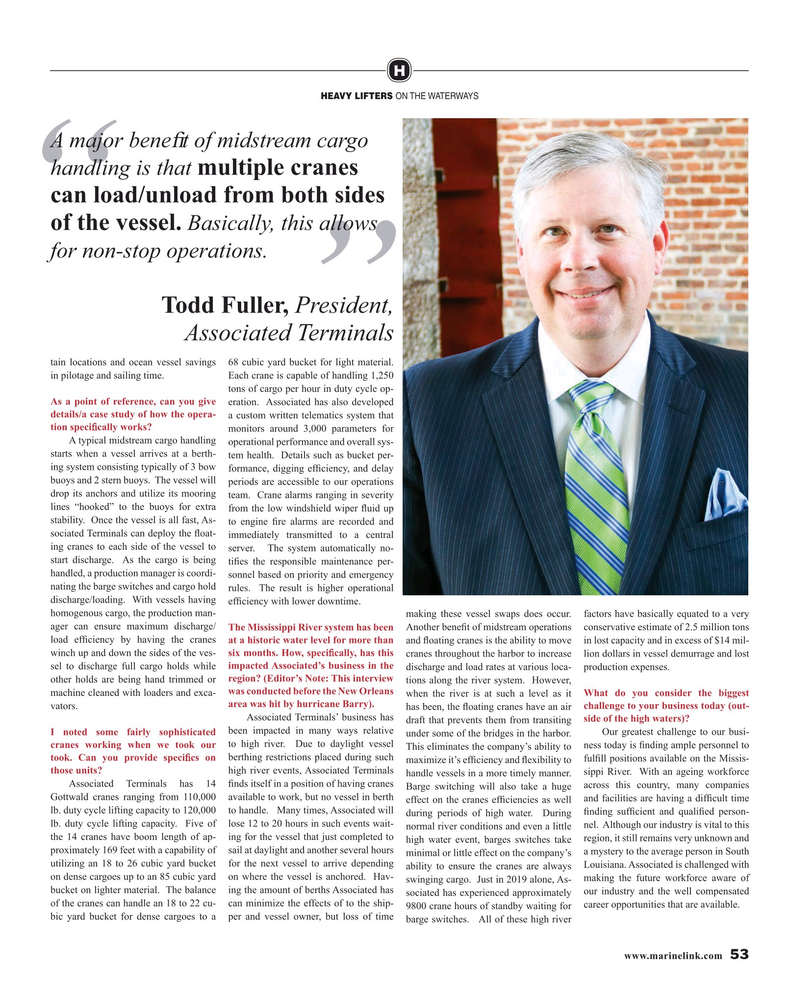
Page 53: of Maritime Reporter Magazine (August 2019)
The Shipyard Edition
Read this page in Pdf, Flash or Html5 edition of August 2019 Maritime Reporter Magazine
H
HEAVY LIFTERS ON THE WATERWAYS
A major bene? t of midstream cargo handling is that multiple cranes can load/unload from both sides of the vessel. Basically, this allows “ ” for non-stop operations.
Todd Fuller, President,
Associated Terminals tain locations and ocean vessel savings 68 cubic yard bucket for light material. in pilotage and sailing time. Each crane is capable of handling 1,250 tons of cargo per hour in duty cycle op-
As a point of reference, can you give eration. Associated has also developed details/a case study of how the opera- a custom written telematics system that tion speci? cally works?
monitors around 3,000 parameters for A typical midstream cargo handling operational performance and overall sys- starts when a vessel arrives at a berth- tem health. Details such as bucket per- ing system consisting typically of 3 bow formance, digging ef? ciency, and delay buoys and 2 stern buoys. The vessel will periods are accessible to our operations drop its anchors and utilize its mooring team. Crane alarms ranging in severity lines “hooked” to the buoys for extra from the low windshield wiper ? uid up stability. Once the vessel is all fast, As- to engine ? re alarms are recorded and sociated Terminals can deploy the ? oat- immediately transmitted to a central ing cranes to each side of the vessel to server. The system automatically no- start discharge. As the cargo is being ti? es the responsible maintenance per- handled, a production manager is coordi- sonnel based on priority and emergency nating the barge switches and cargo hold rules. The result is higher operational discharge/loading. With vessels having ef? ciency with lower downtime.
homogenous cargo, the production man- making these vessel swaps does occur. factors have basically equated to a very ager can ensure maximum discharge/ The Mississippi River system has been Another bene? t of midstream operations conservative estimate of 2.5 million tons load ef? ciency by having the cranes at a historic water level for more than and ? oating cranes is the ability to move in lost capacity and in excess of $14 mil- winch up and down the sides of the ves- six months. How, speci? cally, has this cranes throughout the harbor to increase lion dollars in vessel demurrage and lost sel to discharge full cargo holds while impacted Associated’s business in the discharge and load rates at various loca- production expenses. other holds are being hand trimmed or region? (Editor’s Note: This interview tions along the river system. However, was conducted before the New Orleans machine cleaned with loaders and exca- when the river is at such a level as it What do you consider the biggest area was hit by hurricane Barry).
vators. has been, the ? oating cranes have an air challenge to your business today (out- Associated Terminals’ business has draft that prevents them from transiting side of the high waters)?
I noted some fairly sophisticated been impacted in many ways relative under some of the bridges in the harbor. Our greatest challenge to our busi- cranes working when we took our to high river. Due to daylight vessel This eliminates the company’s ability to ness today is ? nding ample personnel to took. Can you provide speci? cs on berthing restrictions placed during such maximize it’s ef? ciency and ? exibility to ful? ll positions available on the Missis- those units? high river events, Associated Terminals handle vessels in a more timely manner. sippi River. With an ageing workforce Associated Terminals has 14 ? nds itself in a position of having cranes Barge switching will also take a huge across this country, many companies
Gottwald cranes ranging from 110,000 available to work, but no vessel in berth effect on the cranes ef? ciencies as well and facilities are having a dif? cult time lb. duty cycle lifting capacity to 120,000 to handle. Many times, Associated will during periods of high water. During ? nding suf? cient and quali? ed person- lb. duty cycle lifting capacity. Five of lose 12 to 20 hours in such events wait- normal river conditions and even a little nel. Although our industry is vital to this the 14 cranes have boom length of ap- ing for the vessel that just completed to high water event, barges switches take region, it still remains very unknown and proximately 169 feet with a capability of sail at daylight and another several hours minimal or little effect on the company’s a mystery to the average person in South utilizing an 18 to 26 cubic yard bucket for the next vessel to arrive depending ability to ensure the cranes are always Louisiana. Associated is challenged with on dense cargoes up to an 85 cubic yard on where the vessel is anchored. Hav- making the future workforce aware of swinging cargo. Just in 2019 alone, As- bucket on lighter material. The balance ing the amount of berths Associated has sociated has experienced approximately our industry and the well compensated of the cranes can handle an 18 to 22 cu- can minimize the effects of to the ship- 9800 crane hours of standby waiting for career opportunities that are available. bic yard bucket for dense cargoes to a per and vessel owner, but loss of time barge switches. All of these high river www.marinelink.com 53
MR #8 (50-57).indd 53 7/31/2019 2:29:09 PM

 52
52

 54
54
